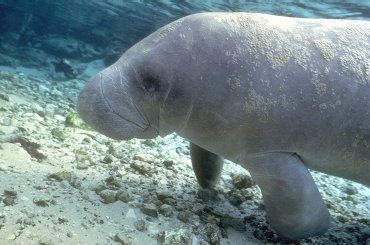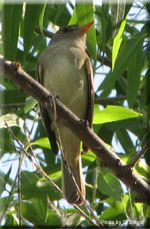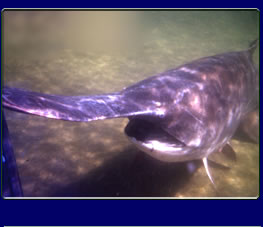- Home
- About S&T
- Taxa/Organisms
- Ecosystems
- Issues
- Methods & Tools
- Reports & Publications
- Location
- Search
Publisher: USGS | Science Center: Florida Integrated Science Center (FISC, Gainesville) | Format: URL
fl.biology.usgs.gov — Web page for the Sirenia Project, a USGS Florida Integrated Science Center project that conducts studies on the West Indian manatee (Trichechus manatus). Includes links to manatee research in the news, international research, publications and presentations, and project staff contact information.

2008 | Publisher: USGS | Science Center: Fort Collins Science Center (FORT, Ft. Collins) | Format: URL
www.fort.usgs.gov — San Acacia Dam is located in a reach of the Rio Grande that has been designated as critical habitat for two endangered species, the Rio Grande silvery minnow (Hybognathus amarus) and the southwestern willow flycatcher (Empidonax traillii extimus). Presently, Rio Grande upstream from the dam is used to convey irrigation water to the Socorro main More...

November 2007 | Publisher: Academic Institution (Sage-grouse Restoration Project (SGRP), Utah State University) | Format: .PDF
sgrp.usu.edu — The greater sage-grouse (Centrocercus urophasianus) and the Gunnison sage-grouse (C. minimus) are species of concern because of their population declines and shrinking geographic distributions. Of continuing interest is the question of population abundance and trends. This publication answers the questions that deal with sage-grouse population, More...

2007 | Publisher: USGS | Science Center: Western Ecological Research Center (WERC, Sacramento) | Format: .PDF
www.werc.usgs.gov — The Alameda whipsnake (Masticophis lateralis euryxanthus) is both a federally and state listed endangered species limited to scrub and chaparral habitat within Contra Costa and Alameda Counties, CA. Loss and fragmentation of habitat due to agricultural and urban development over the last 100 years are cited as the main causes of its decline. Based More...

2007 | Publisher: USGS | Format: URL
pubs.usgs.gov — The Southwestern Willow Flycatcher (Empidonax traillii extimus) is an endangered bird that breeds only in dense riparian habitats in six southwestern states (southern California, extreme southern Nevada, southern Utah, southwestern Colorado, Arizona, and New Mexico). This report synthesizes information on all known Southwestern Willow Flycatcher More...

Publisher: USGS | Science Center: Western Fisheries Research Center (WFRC, Seattle) | Format: URL
wfrc.usgs.gov — The objectives of this study are 1) to determine how and when juvenile suckers use near-shore habitat with emergent vegetation, 2) determine how the distribution and abundance of juvenile suckers varies between near shore and offshore areas as well as between different areas of the lake over time, 3) determine if water quality conditions affect More...

Publisher: USGS | Science Center: Leetown Science Center (LSC, Kearneysville) | Format: URL
www.lsc.usgs.gov — Freshwater bivalves, which are among the most threatened animals in North America, present significant challenges to conservation biologists that attempt to maintain ecological and evolutionary processes within and among populations. Effective management of this rare fauna is often complicated because inadequate information exists for More...

Publisher: USGS | Format: URL
pubs.er.usgs.gov — This report presents the results of the 2006 International Census of Piping Plovers (Charadrius melodus). Two sets of tabular data are reported: one for distribution and abundance of wintering Piping Plovers, the other for distribution and abundance of breeding Piping Plovers. The winter census resulted in the observation of 3,884 Piping Plovers More...

Publisher: USGS | Science Center: Western Fisheries Research Center (WFRC, Seattle) | Format: URL
wfrc.usgs.gov — Threatened and endangered salmonids in the Pacific Northwest often use backwaters and wetlands as they migrate toward the ocean, however our understanding of the role of wetlands to juvenile salmonids is limited. The major Objective of this study was to determine whether juvenile steelhead were being tapped on the wetland during spring, and More...

Publisher: USGS | Science Center: Western Fisheries Research Center (WFRC, Seattle) | Format: URL
wfrc.usgs.gov — Fall chinook salmon (Oncorhynchus tshawytscha) in the Snake River are currently listed as threatened under the Endangered Species Act (ESA). Although fish bypass systems reduce the mortality of fish entering turbine intakes at mainstem hydroelectric dams, they are only operated during the spring, summer, and early fall during the peaks of seaward More...

Publisher: USGS | Science Center: Upper Midwest Environmental Sciences Center (UMESC, LaCrosse) | Format: URL
www.umesc.usgs.gov — Paddlefish (Polyodon spathula) have been lost from four states and Canada, and 11 of 22 states within the remaining species range now list the paddlefish as endangered, threatened, or a species of special concern. Restoration of paddlefish populations is a shared goal of many state and federal agencies. UMESC scientists, in collaboration with the More...

Publisher: USGS | Science Center: Patuxent Wildlife Research Center (PWRC, Laurel) | Format: URL
www.pwrc.usgs.gov — This report assesses and forecasts the status of the Florida manatee population over 50 to 150 years, and examines the relative roles that different threats play in determining the status of these marine mammals, in cooperation with scientists at the Florida Fish and Wildlife Conservation Commission's Fish and Wildlife Research Institute (FWC). More...
